Occasionally, in your journey through life, you meet some very magical individuals. They may be sitting on top of toadstools smoking hookahs. They may be swamp-dwelling, knee-high, green, pointy-eared Jedi with curious speech patterns. They may even be a soft-spoken nonagenarian artist living on quiet, treelined Threadneedle Crescent in North York.
Gerald Lazare’s parents, Maurice and Abiata, were originally from Montreal but moved to Toronto seeking job opportunities and Gerry’s story began over nine decades ago on September 25, 1927, in The Junction a bit north of Toronto’s High Park. The war came along just before Gerry’s twelfth birthday and by his thirteenth birthday, the family had moved to Cloverlawn Ave. in St. Clair and Dufferin to be nearer the millinery shop they operated. Gerry had grown up through The Depression loving to draw, often copying his favourite strips from the Sunday funnies and lapping up the ripping yarns contained between the crimson covers of the British Chums Annuals that were given to him as a gift every Christmas.
During his first semester at Oakwood Collegiate, the Japanese bombed Pearl Harbor. Through his years at high school Jerry (as he liked to be known then) always aspired to draw as well as his favourite comics artists–people like Alex Raymond, Hal Foster, and Will Eisner. Looking for any form of feedback at 15, he sent some samples of his work to Toronto comic book publisher Bell Features down at 165 York St. on the block between Adelaide and Richmond. About a week later he got a call back from Cy Bell himself asking him to come down and start working for them immediately.
This was in the last part of summer of 1943 and Jerry hadn’t yet turned 16. A good number of Bell’s artists had been called up for service including Murray Karn on whose “Jeff Waring” strip Jerry started his comic book career. The irony is that for his first Jeff Waring splash page (that is, his very first professional comic book piece) in Wow Comics No. 17, Jerry swiped Will Eisner’s cover art for Fight Comics No. 3 which he had probably found on the stands in Canada before the ban on American comics. Swiping was and has always been the comic book artist’s lifeline for meeting deadlines and this wouldn’t be the first time he’d reach into his back pocket to fill a Bell Features brief.
His art was crude at this point, but clearly showed promise and with an Art Director of Adrian Dingle’s stature to oversee it, his art grew steadily better, and he was given added features to churn out. Remember that this young teenager, just like almost all the Canadian comic book artists at Bell Features, had to write, layout, pencil, ink, and letter each story himself. Besides “Jeff Waring,” Jerry was asked to take over René Kulbach’s “Phantom Rider” starting in Wow Comics 21, the “Young Commandos” in Commando Comics No. 9 and he even revived John Hilkert’s heroine The Wing starting in Joke Comics No. 14. He became one of the most prolific, if not the most prolific, artists at Bell Features and came to have a reputation for speed without sacrificing quality.
Besides working on other people’s creations, Jerry came up with a few of his own. He began Nitro, a mysterious, maskless, costumed hero with no discernable super abilities, in Dime Comics No. 14. In the very next issue of Dime Comics, Jerry created perhaps his own favourite character suave, two-fisted, noirish, bandleader “Drummy Young.” Drummy reflected Jerry’s passion for Jazz band music, Jerry even drew a sort of Jazz musician collector card at the end of each of the final four installments of “Drummy Young.” These were two passions, art and jazz, that stayed with him for the rest of his life.
In the last three issues of Commando Comics, Jerry created the strip “Tommy Tweed” about the adventures of a redheaded teenage country boy who leaves home seeking adventures. The word balloon on that first “Tommy Tweed” splash page in Commando Comics No. 20 probably has the only use of the word “spalpeen” ever in comic books. Jerry’s most famous creation was the Dreamer in Wow Comics No. 24. It was about a psychiatrist who gained the power to see future crimes in his dreams and then put on a mask and costume to fight them. Adrian Dingle’s version of the Dreamer on the cover of Wow Comics No. 26 has become one of the iconic covers of Canadian wartime comics.
Jerry’s stature at Oakwood Collegiate swelled and everybody knew that Jerry drew some of the comics they were reading. Unsurprisingly, a fellow Oakwood student collared him on a St. Clair streetcar downtown and asked if Jerry could get him into comics as well. That was Ross Mendes, who created the Polka-Dot Pirate for Bell Features and eventually became a fellow art instructor alongside Gerald Lazare at the Ontario College of Art and Design in the early ’70s.
For the first half of his three years at Bell Features, every page Jerry Lazare drew, he drew at home at 76 Cloverlawn Avenue, but just after he turned 17 and, for about the last year of the war, Jerry moved out and began sharing studio space with Fred Kelly who was five years older and just breaking into the comic game with Bell Features. The studio was above The Capitol Theatre on Yonge just north of Eglinton and this was where Jerry was first suckered into playing poker with Fred and a couple of his army buddies.
So far, I’ve used a magnifying glass on Gerald Lazare’s three teenage years as Jerry Lazare, the Bell Features comic book artist, because he always felt it was a significant start to the almost eight decades of art that followed. Even though it was only a sliver in comparison to the career that followed Gerry held it in high regard whenever I talked with him (though he also told me that this hadn’t always been the case when he got a bit snooty about it just after he became a fine artist). He also told me that he had been very frugal with the $5-6 he made from Bell Features for each page he drew and that he had saved enough by the end of his work for Bell that he bought a house for his parents.
After the war Jerry became Gerald Lazare (Gerry to his friends). He did try going down to New York City and looking for comic book work there but found the assembly line, bull pen systems down there not to his liking, given that the Bell Feature artists were all able to work at home or in their own studios and had control over all aspects of their production. Gerry returned to Toronto and started work at one of its biggest engraving houses, Bomac. There he ran into fellow Bell artist Mel Crawford who had just returned from a stint in the navy. Gerry also took up the Famous Artists Course through the friendship he had made with its founder, Albert Dorne, on previous visits to New York City.

In the early 1950s, Gerry did a number of covers for the Harlequin paperback line. He got married to his first wife, Jacqueline and left with her in 1953 to study art in Europe for a year. It was with Jacqueline that Gerry had his son Jeff who is currently a musician in Toronto.
Gerry returned to Toronto in the spring of 1954 and worked another year at Bomac. In 1955 Gerry made the fortunate decision to freelance. In the early 60’s he acquired a New York City agent, Estelle Mandell, who was able to provide him with a steady diet of magazine, book, and business brochure, and LP record cover illustration assignments, right up until about 1973. During this period, Gerry was probably best known for his book illustrations for such authors as Jean Little and Robert Burch’s Queenie Peavy.
In 1966, when he began teaching at the Ontario College of Art (OCA) now known as OCAD University he seemed to prefer being called Gerald and Gerry. After he became a fine artist in the mid-’70s, he elected to teach only part-time in order not to interfere with his painting. He taught at OCA up until 1990. It was at OCA that he reunited with his high school friend, Ross Mendes, who was a fellow instructor there as well.
In 1974, Gerry made a decision to become a fine artist and began working in oils doing portraits and cityscapes. One of the paintings that he created for his first show that year was his homage to Duke Ellington, who had died that year, called “Take the A Train.” It became an iconic print and he sold numerous copies of it all over the world. As a fine artist, he ran into lean times as many artists do and this, in part, led to his divorce from Jacqueline in 1975.
In 1976, Gerry married his second wife Setsuko who had originally come over from Japan in 1972 to study dance. Setsuko also became a fine art painter and you can see samples of her work here. Their home, with studios on the second floor, is chock full of both their work and you can find out more about each of them on their website here. Gerry and Setsuko encapsulated the meeting of their two cultures in their fine art book When East Meets West. Whenever I visited their home, their mutual bond in love and art was palpable.
Gerry Lazare was always a city person at heart and his paintings reflected this. He depicted people on buses, in cafes, waitresses, and street vendors.
He loved city architecture and captured many landmarks such as the Canary Restaurant, the Gladstone Hotel, the Hollywood Jobbers, and the Cats Paw.
Gerry’s work is in many private and corporate collections, and in libraries and archives across North America. His legacy as a Canadian and Toronto painter can only grow in stature in the future.
I want to point out that besides being a painter of the first order, Gerald Lazare was a fantastic storyteller. Maybe one can’t exist without the other.
I had the fortune of contacting Gerry Lazare in 2013 and told him that I had started putting together a book project on Canadian Second World War comic book artists. I asked him if he would consider talking with me about his career in art and would answer some questions I had for him. Gerry agreed and I began meeting with him about every month or so. I would arrive at 1 pm and sit with him and Setsuko in his front room while he answered my questions and reviewed his life and career and talked about things on his mind in general. Each time, after about an hour and a bit, Setsuko would bring a lovely deli cake out, as well as some green tea, and we would have a slice each. Sometimes we would take a trip upstairs to his studio to look at some of his work. Sometimes he would pull a certain art book off his shelves to illustrate a point he was addressing. Sometimes he would take me to a specific piece of work or a photo on his downstairs walls to call attention to another memory. I would try to break away by 3:30 or 4 pm to do battle with that horrid perpetual rush hour on the 401. These were invariably delightful afternoons and I looked forward to them with great anticipation. These visits went on steadily until after my book was published in 2018 and continued afterward until the jackboot occupation of the virus shut the door on them early in 2020.
Gerry would talk about Toronto during the Depression, about the artists who inspired him the most as a teenager (Rubens, Watteau, Ingres, Degas, Sargent, Vermeer), about his streetcar trips on Mondays with his pages under his arm down to the Adrian Dingle’s office at Bell, about his visits to New York City as a teenager and his encounters with Albert Dorne, about his hours of sketching on Toronto Jazz Clubs such as The Montreal Bistro and the Café du Copins, and about his friendships with fellow artists, Will Davies, Tom Bjarnason, Al Hewetson, Ross Mendes, and Lewis Parker.
I remember him mentioning that he and Setsuko loved watching the series “Foyle’s War” on PBS and TVO and that Duke Ellington was always his favourite musician. On occasion, he would rail against Trump and racial inequities. I never asked him about some of the racial caricatures that appeared in his own teenage comic book work. I wonder what he would have said about today’s “cancel culture?”
There was always a dab of wet oil paint on some work or other in his studio. I remember that one time that I had just come in, Gerry was drying off his hands and said that he was touching up a painting of his mother that he was unsatisfied with. He showed me it and I asked him when he had originally painted it and he said: “… about 40 years ago.”
On the occasion of his 90th birthday in 2017, a group of us comic book ‘weirdos’ wanted to pay tribute to him and I arranged for us to visit his home. Here is a picture that Setsuko took of us that day—a day each one of us will always fondly remember.
Gerald Lazare died peacefully at home in his sleep on March 23. I know that Setsuko, his son Jeff and his extended family, as well as the many friends he has made along the way, are justifiably struggling with this. However, though the inevitable entropy of life has removed a certain part of him from us, the memory of his friendship and character as well as the legacy of his artistic vision will always stay with us.












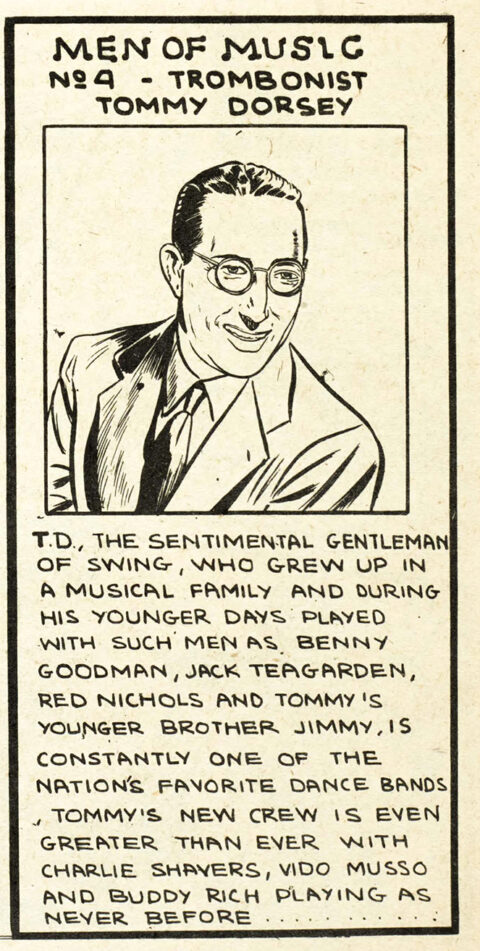
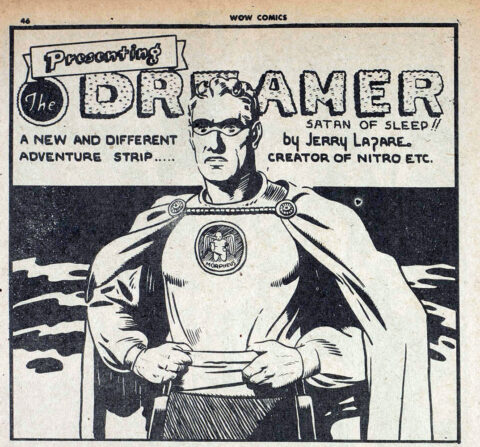


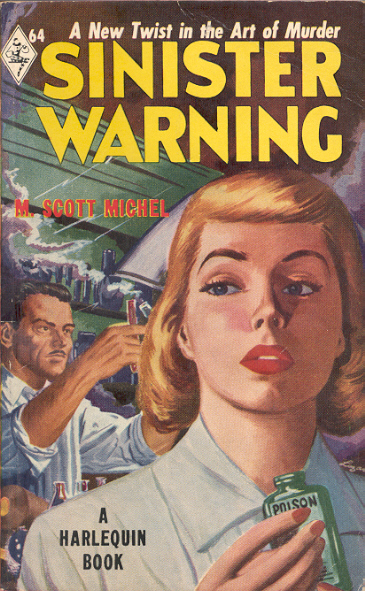
















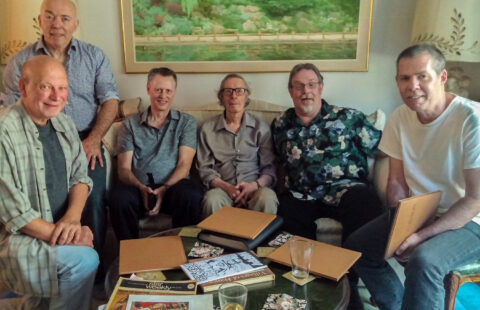

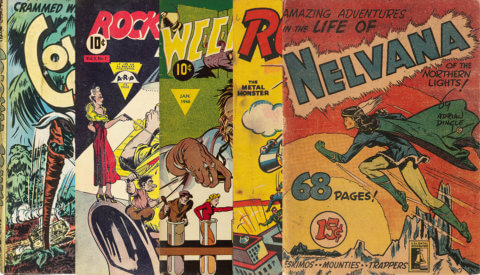


Darn! Another Canadian legend gone. My deepest condolences to the family.
My condolences to Gerry Lazare’s family and friends.
My condolences to Mr. Lazare’s family and friends. Such a wonderful tribute Ivan, thanks you.
Beautiful piece. Thank you.
A great Canadian story teller and artist that you,Ivan, have had a great opportunity to uncover the life of these artists and you share with us.
I’ve worked downtown several decades.
Some of those paintings he drew of buildings in Toronto I’ve seen and heard about, especially the Canary Restaurant one which I am near where I work downtown but beyond where I can fit in to my lunch strolls.
There is a lot of development in that area and in Toronto in general in the last two years and I hope there is still a chance to find some of those places and get to look through the eyes of Gerry and see that same place and then take a snapshot to remember him by.
My condolences to all of Gerry’s family.
This is a fabulous tribute. Thanks. I knew him through his son Jeff. Gerry took us to Massey Hall back in the 70s to see Frank Zappa in his Grand Wazoo period (although he had only the Petit Wazoo lineup with him at that gig), and to Bourbon Street to see Phil Woods. We were only 16 or so. I couldn’t imagine being as dedicated and hard-working as Gerry was at that age. I had much more respect for him than I did for other dads of friends.
Brilliant painter (Setsuko as well), I love his city paintings, thank you for this glimpse into his work and life. His and Setsuko’s website is well worth a read. Sorry he’s gone, very glad you had the chance to meet and talk with him. Condolences to his family.
I missed this back in April but sure enjoyed reading it just now. Gerry’s fine art work is impressive…the painting of Setsuko is my favorite. The Hollywood Jobbers is also amazing, photo-realistic with the wonderful dappled lighting and the boxes of goods for sale right there on the sidewalk.
The Dreamer is a wonderful splash page, shows how professional his work had become and still so young. I really love the 2017 picture of you guys together. I remember when James Waley was in Orb and Power comics, it seems to me I might have been buying Orb direct from him to handle in my catalog? But I admit I just looked him up to make sure who he was. And I found that he helped create the Joe Shuster Awards. Impressive. Hi, James, if you happen to read this.
And good to see Dave Sim here. Ron Kasman’s name rang a bell but I had to Google him also. So I discovered I carry (and enjoyed reading) his “Tower of Comic Book Freaks,” duhhh. He has quite the website filled with comics and portrait work.
Those Harlequin paperback covers of Gerry’s are an eye-opener also. I only know Harlequin (this incarnation, not the romance publisher) for their collecting the rare Golden Amazon stories from the pulps in several terribly rare editions. Very cool books if you can find them. Now I have more covers by Gerry to keep an eye out for. Did he do many more paperback covers?
Wonderful picture of Gerry at his drawing board in 1947, and with Albert Dorne and friends…that’s so cool that old pros like Dorne was spending time with youngsters, even back then. Dorne became the face of the Famous Artist’s School in countless advertising.
Wonderful piece Ivan, one of my favorites. An interesting, unique artist and lots of fun artwork. Thanks!